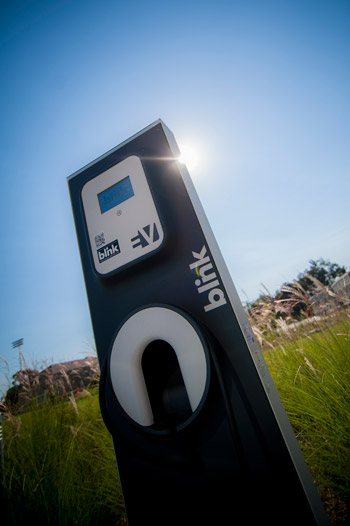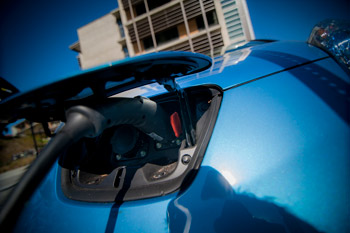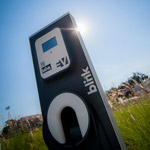
California Energy Commission Awards More Than $1.8 Million for UC San Diego Microgrid Projects
Clean energy projects provide a model for the future of electric vehicle charging and localized power generation and storage
By:
- Laura Margoni
Published Date
By:
- Laura Margoni
Share This:
Article Content

Photos by Erik Jepsen/UC San Diego Publications
The University of California, San Diego is on track to having the largest, most diverse range of electric vehicle charging stations at any university in the world thanks, in part, to recent awards from the California Energy Commission. The commission approved funding of $220,554 to expand the campus’s burgeoning charging network for plug-in electric vehicles. By June 2013, the university expects to have a total of 54 charging outlets, with more than 70 percent available for public use.
“This is a great opportunity for the university to build on efforts to reduce the carbon footprint of the campus,” said Gary C. Matthews, UC San Diego vice chancellor for Resource Management and Planning. “The expansion of our electric vehicle charging infrastructure complements our existing operations and research efforts while supporting the state’s efforts to create a clean energy transportation sector – and foster innovation and investment in California.”
The commission also approved $1.6 million in funding to advance development of UC San Diego’s pioneering microgrid, an increase of its previously awarded funding of $1,394,298 for the university’s electric microgrid. The university is providing an additional $1,525,000 in match funding. These funds will be invested, in part, in analyzing multiple stand-alone energy storage technologies to further improve the microgrid.
“The return on this investment extends far beyond the San Diego campus,” said Energy Commission Chair Robert B. Weisenmiller. “It provides a crucial real-life demonstration of technology that can help to provide California a future of clean, sustainable and reliable energy.”
The microgrid is a small-scale version of the traditional larger power grid that draws energy from clean sources such as the wind and sun, as well as from conventional technology. It is able to connect to the larger electric grid, but can also work independently. In addition, the microgrid can more efficiently manage real-time demand, supplying and storing energy at a lower cost with less pollution than a conventional grid.
The microgrid at UC San Diego serves a campus community of more than 45,000 people, and generates more than 90 percent of the electricity used on campus annually. The university saves more than $800,000 in power costs per month because of its microgrid. The project has also spurred investment: The nearly $4 million that the Energy Commission has invested in the microgrid since 2008 has been leveraged to garner more than $4 million from other funding sources, public and private.

New jobs and new opportunities are coming to California through the UC San Diego microgrid and electric vehicle charging projects.
San Diego County-based Alternative Energy Systems Consulting, Inc., will receive the Energy Commission’s award of $220,554 to purchase and install eight dual RWE Level 2 eStation Smart Systems, providing 16 charging outlets, and to install and assess the performance of three publicly accessible RWE DC fast chargers.
RWE Effizienz GmBH, a subsidiary of a German utility, which is the maker of the charging equipment, has selected Monrovia-based AeroVironment, Inc., as its designated assembler and distributor of RWE DC fast chargers and AC intelligent chargers for the U.S. and Canada markets. RWE had previously worked with a Wisconsin-based business.
These awards come on the heels of another award to expand UC San Diego’s electric vehicle charging infrastructure. In November 2012, the Energy Commission awarded $69,446 to Alternative Energy Systems Consulting, Inc., to install five RWE Level 2 electric vehicle charging systems, each consisting of two charging outlets for a total of 10 charging outlets to support the campus’s growing fleet of plug-in electric vehicles.
Level 2 electric vehicle charging systems are expected to become the most commonly used charging systems. They use 208-240 volt power and typically provide 10 to 20 miles of range for each hour of charging for a passenger vehicle. Level 1 charging systems use 110 volt power, standard in most households, and typically provide 2 to 5 miles of range for each hour of charging. DC fast-charging systems are emerging as a much quicker way to charge plug-in electric vehicles, typically providing 60 to 80 miles of range in just 20 minutes of charging.
Recognized as a leader in clean transportation, nearly half of UC San Diego’s fleet of more than 800 vehicles has been converted to near-zero emission vehicles. Diesel fuel has been replaced with ultra-low sulfur biodiesel, and many buses, street sweepers, cars and trucks have been converted to run on compressed natural gas. The fleet also includes five Nissan Leafs and more than 50 hybrid-electric vehicles. The university’s “green fleet” was ranked 14th overall in the nation and received the highest ranking of any university by Government Green Fleet in 2012.
“These investments in charging infrastructure are crucial to fulfilling the Governor’s executive order to significantly expand the market for zero emission vehicles in California,” said Commission Chair Weisenmiller. “In addition, they will improve air quality, reduce petroleum use and create jobs.”
Governor Brown’s executive order directs state government to support and facilitate the rapid commercialization of zero-emission vehicles (ZEVs) in California, with a 2025 target of 1.5 million ZEVs on California roads. The order also requires that sufficient infrastructure be installed in the state to support 1 million ZEVs by 2020.
Share This:
You May Also Like
Stay in the Know
Keep up with all the latest from UC San Diego. Subscribe to the newsletter today.



